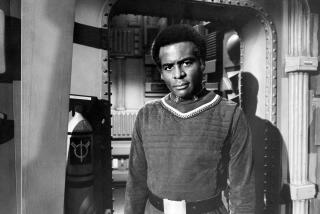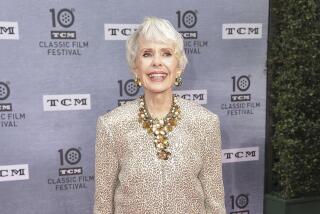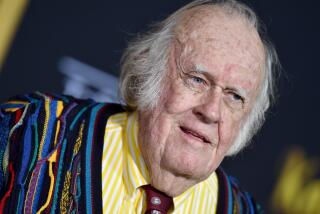Rod Taylor dies at 84; actor starred in ‘The Birds,’ ‘Time Machine’
When actor Rod Taylor started out in his native Australia in the early 1950s, he won an acting award that included a round-trip ticket to London.
But when the flight stopped in Los Angeles, he got off the plane and stayed, launching a prolific six decades in Hollywood.
After a relatively short period of struggle, he was in major films, acting opposite Elizabeth Taylor in the 1956 classic “Giant,” starring in the hit 1960 adaptation of H.G. Wells’ “The Time Machine” and playing the male lead in Alfred Hitchcock’s revered 1963 thriller “The Birds.”
Taylor, 84, died of natural causes Wednesday at home in Beverly Hills, said Carol Taylor, his wife of 35 years.
Although he never rose to being a top-level star in Hollywood, he amassed nearly 100 credits, including dramas such as “The V.I.P.s,” with Elizabeth Taylor and Richard Burton; biopics such as John Ford’s “Young Cassidy,” in which he played playwright Sean O’Casey; a couple of light-comedy Doris Day movies; and animation in which he was the voice of Pongo in Disney’s 1961 “101 Dalmatians.”
Taylor even ventured into the avant-garde with a part in Michelangelo Antonioni’s 1970 “Zabriskie Point.”
On television, Taylor had roles in numerous series, including early TV’s “Studio 57” and “Playhouse 90,” “Falcon Crest” in the 1980s and “Murder, She Wrote” in the 1990s.
Taylor finally retired in his late 70s. But then came a call from his business manager saying that a “strange guy” wanted to talk to him. It was Quentin Tarantino, who was casting his World War II film “Inglourious Basterds.”
“He said, ‘How about doing a movie with me?’” Taylor told the Palm Beach Post in 2009. “‘I want you to play Winston Churchill. We’re shooting in Germany.’”
Taylor thought it was a long way to go for an actor to play the role. “I said, ‘Well, you’re just across the channel from Albert Finney, aren’t you?’ And he said, ‘Well, if Rod Taylor turns me down, then I’ll get Albert Finney.’”
Although the role was small, Taylor approached it seriously, watching news clips and documentaries to get the British leader’s voice and body language right.
“I enjoyed every second of the 10 days,” he said of the shoot.
It was his last movie credit.
Taylor was born Jan. 11, 1930, in Sydney. After high school, he considered a career in engineering. He also studied to be an artist but didn’t get far.
“I hit my highest peak with art when I got a job painting backdrops for fashion window displays,” he told Hollywood columnist Hedda Hopper in 1962.
Then he saw Laurence Olivier in a touring production of Shakespeare’s “Richard III,” and it changed his life. “After that,” he said, “I knew what I wanted to do.”
Taylor’s early work in radio set in motion a prolific career. “I did almost 20 different daytime shows a week, hopping from studio to studio, playing nearly every imaginable character,” he said in a 1967 interview in People magazine in Australia.
Early in his U.S. career he was signed to a contract by MGM, appearing in a key role in the 1956 family drama “The Catered Affair,” with Bette Davis and Debbie Reynolds.
Mostly he played supporting roles until his breakthrough as the star of “The Time Machine,” about a turn-of-the-century inventor whose contraption transports him thousands of years into the future. Taylor enjoyed making the film, in part because of his fondness for director George Pal, who specialized in fantasy and science fiction.
“George Pal lived in this fantasy land, and he had a wonderful imagination, as you can see on the screen,” Taylor told the Hamilton Spectator in 2005. “There was no computerization in those days, and it was all about the characters.”
Taylor was offered a role in the 2002 remake of the film starring Guy Pearce, but he turned it down because he didn’t like the script, saying there were “no character relationships.”
But the filmmakers sneaked Taylor into the remake by putting a photo of him from the 1960 original in the background for a sequence.
Taylor took it in stride. “My career,” he told the Spectator with a laugh, “has come down to being a photo in the background.”
Besides his wife, Taylor is survived by daughter Felicia Taylor, a journalist formerly with CNN.
Twitter: @davidcolker
More to Read
Start your day right
Sign up for Essential California for the L.A. Times biggest news, features and recommendations in your inbox six days a week.
You may occasionally receive promotional content from the Los Angeles Times.







